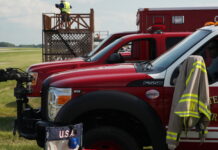Following the crash in Shoreham, England, last August, ICAS began working with British officials to share lessons learned and to discuss potential improvements to our respective air show industries. Working with the British Air Accidents Investigation Branch (AAIB), the UK equivalent of the United States’ National Transportation Safety Board or the Canadian Transportation Safety Board, ICAS provided its perspective to the UK authority on aviation safety.
The dialogue between the AAIB and ICAS created a productive, two-way flow of ideas. Both the UK and North American air show industries have unique approaches to air show safety, and engaging in dialogue with others familiar with the minutiae of local regulations invited a fresh perspective. Our discussion inevitably led to a review of accident statistics, which is particularly relevant during the winter months of preparation for the 2016 air show season.
ICAS began thoroughly tracking accident statistics in 1988; if we consider the trends of each decade since this tracking began, we can more accurately gauge its effectiveness. For discussion purposes, I’ve broken the applicable accident data into three distinct periods: 1988 to 1997, 1998 to 2007, and 2008 to the present, a ten-year stretch that won’t finish until the end of the 2017 air show season.
During the ten-year period from 1988 to 1997, there were 65 fatal air show accidents (6.5 fatal accidents per year). From 1998 to 2007, there were 33 fatal air show accidents (3.3 fatal accidents per year), and from 2008 to 2015, there were 18 fatal air show accidents (2.25 fatal accidents per year).
Any objective analysis should note anomalies which may have played a part in altering the accident rates in either direction. One of these was the agreement between ICAS and the FAA to delegate day-to-day management and administration of the Aerobatic Competency Evaluation (ACE) program from the FAA to ICAS at the end of the 1990 season. Quite controversial at the time, this change had a drastic impact on the number of fatal air show accidents. And the impact was immediate. In the three years prior to ICAS assuming responsibility for ACE evaluations, the average number of fatal accidents was 12.3 per year. In the three years following ICAS assuming this responsibility, the average was 3.7. And, in the seven years after ICAS began its involvement, the average was 4.7 fatal accidents per year.
The air show industry’s goal is zero fatal accidents, but, to achieve this goal, thoughtful consideration of the data is required. Analyzing, understanding and internalizing these accident statistics should give all of us reason to be proud of the progress we’ve made during the last 25 years, but it should also be clear that there is still much room for improvement and reason to believe that continued attention can and will produce those improvements. While we can demonstrate empirically that the industry is getting safer, we must accept that safer is simply not good enough. Thankfully, the road map for achieving our collective goal is laid out in the data, and to find the solution, we need look no further than ourselves.
In 1990, the air show industry had the worst year in recent history with 14 fatal accidents. And that tragic year followed the 1988 and 1989 seasons when the air show community suffered through 11and12 fatal accidents, respectively. The industry rallied together and agreed that the way to improve was not to wait for solutions from outside the industry, but to develop and implement those measures ourselves. Despite considerable opposition from some segments of our business, industry leaders committed themselves, and the entire air show community, to a system of self-policing, and the results were immediate, dramatic and quantifiable.
In 2007, several highly publicized accidents spurred the industry to take another introspective look, and the initiative to change the culture of air show safety was launched. This effort built upon the success of the ACE program, encouraged open discussion about safety-related issues, and again, reduced the accident rate.
The introduction of these two programs – ICAS’s administration of the ACE program in 1990, and the initiative to change the culture of air show safety in 2007 — has resulted in a quantum shift in our safety paradigm and in our most impactful and lasting achievement during the last three decades. And they occurred when our business took an objective look at itself and made the decision to take action ourselves rather than wait for others, from outside the industry, to foist unwelcome or less effective solutions on us.
No regulation or policy has had as measurable an impact as when we, as an industry, have put our heads together and committed to striving for a safer and more professional business. It has been almost a decade since ICAS and its members introduced the newest, lifesaving change in how we approach air show safety, but we cannot stop now. Our goal is zero accidents. If we truly commit now to this goal for 2016, we will achieve it. After all, every important advancement the air show industry has ever achieved was the result of shouldering the responsibility ourselves.








